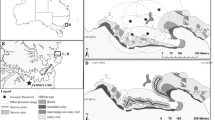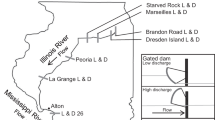Synopsis
We present ways to test the assumptions of the Petersen and removal methods of population size estimation and ways to adjust the estimates if violations of the assumptions are found. We were motivated by the facts that (1) results of using both methods are commonly reported without any reference to the testing of assumptions, (2) violations of the assumptions are more likely to occur than not to occur in natural populations, and (3) the estimates can be grossly in error if assumptions are violated. We recognize that in many cases two days in the field is the most time fish biologists can spend in obtaining a population estimate, so the use of alternative models of population estimation that require fewer assumptions is precluded. Hence, for biologists operating with these constraints and only these biologists, we describe and recommend a two-day technique that combines aspects of both capture-recapture and removal methods. We indicate how to test: most of the assumptions of both methods and how to adjust the population estimates obtained if violations of the assumptions occur. We also illustrate the use of this combined method with data from a field study. The results of this application further emphasize the importance of testing the assumptions of whatever method is used and making appropriate adjustments to the population size estimates for any violations identified.
Similar content being viewed by others
References cited
Alexander, G.R. & E.A. Hansen. 1983. Sand sediment in a Michigan trout stream. Part II. Effects of reducing sand.bedload on a trout population. N. Amer. J. Fish. Manag. 3: 365–372.
Bailey, N.T.J. 1951. On estimating the size of mobile populations from recapture data. Biometrika 38: 293–306.
Bailey, N.T.J. 1952. Improvements in the interpretation of recapture data. J. Anim. Ecol. 21: 120–127.
Begon, M. 1979. Investigating animal abundance: capture-recapture for biologists. University Park Press, Baltimore. 97 pp.
Bell, G. 1974. Population estimates from recapture studies in which no recaptures have been made. Nature (London) 248: 616.
Bishop, J.A. & D.J. Hartley. 1976. The size and age structure of rural populations of Rattus norvegicus containing individuals resistant to the anti-coagulant poison warfarin. J. Anim. Ecol. 45: 623–646.
Blower, J.G., L.M. Cook & J.A. Bishop. 1981. Estimating the size of animal populations. George Allen and Unwin Limited, London. 128 pp.
Boguslavsky, G.W. 1956. Statistical estimation of the size of a small population. Science 124: 317–318.
Bohlin, T. & B. Sundström. 1977. Influence of unequal catchability on population estimates using the Lincoln index and the removal method applied to electrofishing. Oikos 28: 123–129.
Brownie, C. & D.S. Robson. 1983. Estimation of time-specific survival rates from tag-resighting samples: a generalization of the Jolly-Seber model. Biometrics 39: 437–453.
Buckland, S.T. 1980. A modified analysis of the Jolly-Seber capture-recapture model. Biometrics 36: 419–435.
Carle, F.L. & M.R. Strub. 1978. A new method for estimating population size from removal data. Biometrics 34: 621–630.
Caughley, G. 1977. Analysis of vertebrate populations. John Wiley, New York. 234 pp.
Chapman, D.G. 1951. Some properties of the hypergeometric distribution with applications to zoological sample censuses. Univ. Calif. Publ. Statistics 1: 131–160.
Chapman, D.W. & E. Knudsen. 1980. Channelization and livestock impacts on salmonid habitat and biomass in western Washington. Trans. Amer. Fish. Soc. 109: 357–363.
Cooper, G.P. & K.F. Lagler. 1956. The measurement of fish population size. Trans. North Amer. Wildl. Conf. 21: 281–297.
Cormack, R.M. 1966. A test for equal catchability. Biometrics 22: 330–342.
Crisp, D.T., R.H.K. Mann & J.C. McCormack. 1974. The populations of fish at Cow Green, upper Teesdale, before impoundment. J. Appl. Ecol. 11: 969–996.
Crisp, D.T, R.H.K. Mann & J.C. McCormack. 1975. The populations of fish in the River Tees system on the Moor House National Nature Reserve, Westmorland. J. Fish Biol. 7: 573–593.
DeLury, D.B. 1947. On the estimation of biological populations. Biometrics 3: 145–167.
Eberhardt, L.L. 1978. Appraising variability in population studies. J. Wildl. Manag. 42: 207–238.
Egglishaw, H.J. 1970. Production of salmon and trout in a stream in Scotland. J. Fish Biol. 2: 117–136.
Egglishaw, H.J. & P.E. Shackley. 1977. Growth, survival and production of juvenile salmon and trout in a Scottish stream. 1966–1975. J. Fish Biol. 11: 647–672.
Fraser, J.M. 1978. The effect of competition with yellow perch on the survival and growth of planted brook trout, splake, and rainbow trout in a small Ontario lake. Trans. Amer. Fish. Soc. 107: 505–517.
Gaskell, T.J. & B.J. George. 1972. A Baysian modification of the Lincoln index. J. Appl. Ecol. 9: 377–384.
Goldspink, C.R. 1979. The population density, growth rate and production of roach Rutilus rutilus (L) in Tjeukemeer, The Netherlands. J. Fish Biol. 15: 473–498.
Hartzler, J.R. 1983. The effects of half-log covers on angler harvest and standing crop of brown trout in McMichaels Creek, Pennsylvania. N. Amer. J. Fish. Manag. 3: 228–235.
Hauber, A.B. 1983. Two methods for evaluating fingerling walleye stocking success and natural year-class densities in Seven Island Lake, Wisconsin, 1977–1981. N. Amer. J. Fish. Manag. 3: 152–155.
Hayne, D.W. 1949. Two methods for estimating population from trapping records. J. Mammal. 30: 399–411.
Hoopes, R.L. 1975. Flooding as the result of hurricane Agnes, and its effect on a native brook trout population in an infertile headwater stream in central Pennsylvania. Trans. Amer. Fish. Soc. 104: 96–99.
Howells, E.J., M.E. Howells & J.S. Alabaster. 1983. A field investigation of water quality, fish and invertebrates in the Mawddach river system, Wales. J. Fish Biol. 22: 447–469.
Hunt, R.L. 1976. A long-term evaluation of trout habitat development and its relation to improving management-related research. Trans. Amer. Fish. Soc. 105: 361–364.
Jacobs, K.E. & W.D. Swink. 1982. Estimations of fish population size and sampling efficiency of electrofishing and rotenone in two Kentucky tailwaters. N. Amer. J. Fish. Manag. 2: 239–248.
Jensen, A.L. 1981. Sample sizes for single mark and single recapture experiments. Trans. Amer. Fish. Soc. 110: 455–458.
Keller, C.R. & K.P. Burnham. 1982. Riparian fencing, grazing, and trout habitat preference on Summit Creek, Idaho. N. Amer. J. Fish. Manag. 2: 53–59.
Leslie, P.H. 1958. Statistical appendix. J. Anim. Ecol. 27: 84–86.
Leslie, P.H. & D.H.S. Davis. 1939. An attempt to determine the absolute number of rats on a given area. J. Anim. Ecol. 8: 94–113.
Mahon, R. 1980. Accuracy of catch-effort methods for estimating fish density and biomass in streams. Env. Biol. Fish. 5: 343–360.
Mann, R.H.K. 1971. The populations, growth and production of fish in four small streams in southern England. J. Anim. Ecol. 40: 155–190.
Marten, G.G. 1970. A regression method for mark-recapture estimation of population size with unequal catchability. Ecology 51: 291–295.
Moran, P.A.P. 1951. A mathematical theory of animal trapping. Biometrika 38: 307–311.
Mortensen, E. 1977. The population dynamics of young trout (Salmo trutta L.) in a Danish brook. J. Fish Biol. 10: 23–33.
Murphy, M.L., C.P. Hawkins & N.H. Anderson. 1981. Effects of canopy modification and accumulated sediment on stream communities. Trans. Amer. Fish. Soc. 110: 469–478.
Neves, R.J. & G.B. Pardue. 1983. Abundance and production of fishes in a, small Appalachian stream. Trans. Amer. Fish. Soc. 112: 21–26.
Otis, D.L., K.P. Burnham, G.C. White & D.R. Anderson. 1978. Statistical inference from capture data on closed animal populations. Wildlife Monogr. 62: 1–135.
Pasanen, S., M. Viljanen & E. Pulkkinen. 1979. Stress caused by the ‚mark-recapture’ method to Coregonus albula (L.) J. Fish Biol. 14: 597–605.
Peterson, N.P. & C.J. Cederholm. 1984. A comparison of the removal and mark-recapture methods of population estimation for juvenile coho salmon in a small stream. N. Amer. J. Fish. Manag. 4: 99–102.
Petrosky, C.E. & T.F. Waters. 1975. Annual production by the slimy sculpin population in a small Minnesota trout stream. Trans. Amer. Fish. Soc. 104: 237–244.
Pollock, K.H. 1981. Capture-recapture models allowing for age-dependent survival and capture rates. Biometrics 37: 521–529.
Pollock, K.H. 1982. A capture-recapture design robust to unequal probability of capture. J. Wildl. Manag. 46: 752–757.
Pollock, K.H., D.L. Solomon & D.S. Robson. 1974. Tests for mortality and recruitment in a K-sample tag-recapture experiment. Biometrics 30: 77–87.
Ricker, W.E. 1975. Computation and interpretation of biological statistics of fish populations. Bull. Fish. Res. Board Can. 191: 1–382.
Robson, D.S. & W.A. Flick. 1965. A non-parameterc statistical method for culling recruits from a mark-recapture experiment. Biometrics 21: 936–947.
Robson, D.S. & H.A. Regier. 1964. Sample size in Petersen mark-recapture experiments. Trans. Amer. Fish. Soc. 93: 215–226.
Roff, D.A. 1973. An examination of some statistical tests used in the analysis of mark-recapture data. Oecologia (Berlin) 12: 35–54.
Schnute, J. 1983. A new approach to estimating populations by the removal method. Can. J. Fish. Aquat. Sci. 40: 2153–2169.
Seber, G.A.F. 1973. The estimation of animal abundance and related parameters. Hafner Press, New York. 506 pp.
Seber, G.A.F. & E.D. LeCren. 1967. Estimating population parameters from catches large relative to the population. J. Anim. Ecol. 36: 631–643.
Seber, G.A.F. & J.F. Whale. 1970. The removal method for two and three samples. Biometrics 28: 393–400.
Serns, S.L. 1982. Relationship of walleye fingerling density and electrofishing catch per effort in northern Wisconsin lakes. N. Amer. J. Fish. Manag. 2: 38–44.
Skalski, J.R. & D.S. Robson. 1982. A mark and removal field procedure for estimating population abundance. J. Wildl. Manag. 46: 741–751.
Skalski, J.R., D.S. Robson & M.A. Simmons. 1983. Comparative census procedures using single mark-recapture methods. Ecology 64: 752–760.
Stauffer, T.M. 1979. Two-year cycles of abundance of Age-0 rainbow trout in Lake Superior tributaries. Trans. Amer. Fish. Soc. 108: 542–547.
Tanaka, R. & M. Kanamori. 1967. New regression formula to estimate the whole population for recapture-addicted small mammals. Research Pop. Ecol. 9: 83–94.
Thorpe, J.E. 1974. Estimate of the number of brown trout Salmo truua (L.) in Loch Leven, Kinross, Scotland. J. Fish Biol. 6: 135–152.
Vincent, R. 1971. River electrofishing and fish population estimates. Progr. Fish-Culturist 33: 163–169.
Wilbur, H.M. & J.M. Landwehr. 1974. The estimation of population size with equal and unequal risks of capture. Ecology 55: 1339–1348.
Williams, R. & M.R. Harcup. 1974. The fish populations of an industrial river in south Wales. J. Fish Biol. 6: 395–414.
Workman, D.L. 1981. Recovery of rainbow trout and brown trout populations following chemical poisoning in Sixteenmile Creek, Montana. N. Amer. J. Fish. Manag. 1: 144–150.
Zippin, C. 1956. An evaluation of the removal method of estimating animal populations. Biometrics 12: 163–169.
Zippin, C. 1958. The removal method of population estimation. J. Wildl. Manag. 22: 82–90.
Author information
Authors and Affiliations
Rights and permissions
About this article
Cite this article
Gatz, A.J., Loar, J.M. Petersen and removal population size estimates: combining methods to adjust and interpret results when assumptions are violated. Environ Biol Fish 21, 293–307 (1988). https://doi.org/10.1007/BF00000377
Received:
Accepted:
Issue Date:
DOI: https://doi.org/10.1007/BF00000377




